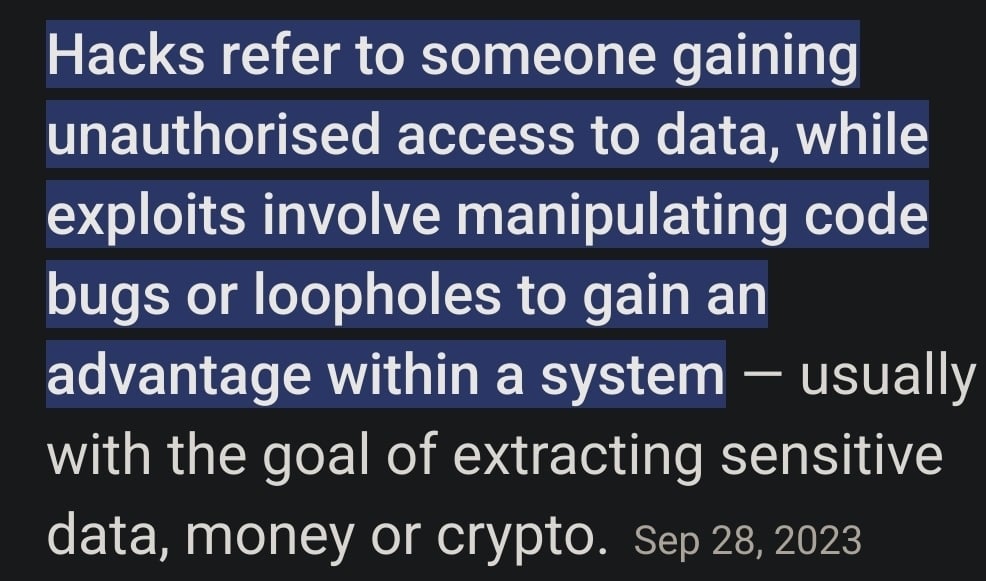- cross-posted to:
- selfhosted@lemmit.online
- cross-posted to:
- selfhosted@lemmit.online
Companies need to stop using Authy. It’s stupid and pointless when we have a open alternative such as the one used by Google Authenticator or Aegis.
You know it’s bad when people recommend something made by Google over it.
I started using Authy instead of GA because every time I changed the ROM on my phone I would lose all codes, because I would forget every time.
Use aegis, export the keys and then reimport them every time you switch. Trusting your second factor to a cloud is a disaster waiting to happen.
If you want to get fancy setup your own cloud server (nextcloud, Seafile, owncloud etc) and set the backup folder for aegis to the self hosted cloud for easy restore every time you switch ROMs.
I’ve started putting mine into my Bitwarden vault as well as Google auth, mainly because I’m a bit paranoid I’ll wind up locked out of something by trusting a second factor too much
With password recovery you shouldn’t be getting locked out of anything. I don’t see this being a risk.
Red Shazam
Wow, it’s literally the shazam logo, flipped horizontally and red.
Wonder who got paid to make that logo?
I realized long time ago that I don’t want my 2FA be tied to my phone number. And then i found you can’t export your data from Authy because they know they are scummy fucks and don’t want to anyone to leave
You can, though. But not through their app. Someone reverse engineered their protocol and wrote a program that connects like a new client, which you then approve, and it dumps all your random seeds into a text file. I then put them all into Keepass.
Edit: Unfortunately, the author has deprecated the project as Authy has added some attestations to their API, seemingly for this exact issue. https://github.com/alexzorin/authy?tab=readme-ov-file
People keep acting like Authy is betraying them by not having an export feature, but why exactly are you leaving Authy to begin with? Because they are a security risk?
You’re gonna leave Authy a copy of your seeds? That defeats the purpose.
Re-key your MFA codes on the way out. Security isn’t necessarily convenient.
then i found you can’t export your data from Authy
Exporting data from a 2FA app sounds like the opposite of secure. Not to mention you don’t want your 2FA codes on Authy (or any other 2FA app) to remain valid if you’re not using it.
When I switched from Google Authenticator to Authy years ago, I went through each 2FA-enabled account one by one to disable 2FA and then re-enable it using Authy. It’s a long process depending on how many accounts you have 2FA enabled on, but it’s worth it.
Reading the OP, looks like it’s time to generate new keys for all my 2FA accounts.
If you can’t export / save / transfer codes then you need to regenerate all your 2fa codes every time you switch to a new device.
2FA doesn’t need to be infallible, it just needs to be a second factor.
So what did you do?
On Android, I replaced Authy with the open-source Aegis app. It’s just as functional, allows exporting, and doesn’t tie your data to your phone number (nor store it on a central system–not sure if Authy does this or not).
Does anyone have a suggested alternative for authy? (Please read the whole post before responding)
I’d love to go with an open source solution as I’ve done with my password manager, but that doesn’t seem possible with one of my big requirements:
Scenario: I’ve had my phone robbed abroad and managed to buy a new one and loaded my ESIM back into it—I need to recover access to my 2 factor database via SMS so I’m able to log into my cloud storage and access my password database.
At this point I’d probably be happy to host a service myself on something like AWS and use SNS for this requirement, but I’m not sure anything like that exists ready to go. I’m not particularly interested in rolling something myself for this.
I’d be dubious of jumping from one closed source product to another, but if there’s a particularly good option I’m all ears, I’ve been otherwise happy with authy for about a decade now, but this plus the retirement of the desktop app have me looking elsewhere.
Edit: added emphasis
Bitwarden has 2FA built in, and you can host it yourself if you want.
I’ve looked into this before and unfortunately it doesn’t support the SMS requirement I have in my deal-breaker scenario—do you know if this has changed and can point me to the docs regarding it?
Oops, missed that part. Not that I know of, though SMS is a terrible way to do 2FA. It annoys me so many businesses and banks use it.
I agree it’s much worse than using a modern OTP app, but I need a way to access my OTP database when the only form of digital identity I have access to is my phone number.
Authy currently supports this scenario for me (with a load of checks, it doesn’t happen instantly), so I would require a like for like replacement
Bitwarden has a 2FA recovery code possible so you could use a unlabeled hard copy of the code. It cycles after every use so it would get you one recovery and doesn’t use SMS so it’s immune to SMS shenanigans.
That’s potentially a solution then, as I guess in order to buy a new phone I would need to have not lost my wallet too at least, so I guess I could keep those items together for equivalent recovery possibility
Okay that may be a goer, I’ll look a bit more into it, thanks!
Aegis is often recommended as an open source solution : https://github.com/beemdevelopment/Aegis
Interesting, I’ve seen this one before but it didn’t seem like it would support my deal-breaker scenario—I still can’t seem to see support for that on the readme, could you point me at some docs?
The point is you physically and locally back up the database. Put it on your computer, or a flash drive or whatever. You can set a different, longer password for backups, and I would recommend you do that. When you get your new phone, you just copy the database into it and load it into a freshly installed Aegis. You don’t even need to self host anything, there is nothing to host.
Not everything needs to be “in the cloud”. I think this event illustrates nicely why.
This is specifically a scenario where I’m starting from a single blank device because I’ve just been robbed on the other side of the planet.
Edit: for added weight, I’ve been in this exact scenario. I was able to get my ESIM reprovisioned to a new phone and recover everything within a day. I don’t want to replace authy with a solution that doesn’t cover that scenario
Well I thought this was kinda obvious what I meant, but I guess not. What you say is a requirement (sms recovery of a cloud account) is just one of many solutions to your specific problem. I’ll just list off a few solutions below that involve neither SMS (the most insecure communication method in common use today) and only optionally a cloud account. For cimplicity sake I’ll stick to Aegis, where you can create password-protected local backups you can then put wherever you want. This password needs to be very strong for obvious reasons: I would recommend a long sentence (40 characters or more) that you can just remember, like a quote from a movie/tv show/book/poem or something, including normal punctuation as a sentence for example.
Solution 0: This is more of a trivial solution I wouldn’t actually recommend. You can allow account recovery via eMail and have your eMail not use 2fa, but a long/good password so you can login from memory (see above). This is probably more secure than SMS for the recovery-case, but less secure for the everyday use case of eMail, therefore “not recommended”.
Solution 1: USB Sticks are tiny, as in the size of a USB port (slightly longer but slimmer for USB-C). If you want to have a backup “on you”, I’m sure you can find a place where it wouldn’t get robbed with the phone/wallet. A tiny pocket somewhere, a string around your ankle, make a compartment in your shoe, or just have it with your luggage at the hotel. I’m sure you get the point. You get your new phone, you plug in the USB, you install Aegis and restore the backup.
Solution 2a: Dedicated “online” storage. This can be self hosted, or a free account of any cloud provider, but the important part is that it does NOT require 2FA and you do NOT use it for anything else. You have the backup in there. It also needs a very secure password (again: long, but easy to remember, no garbled letter nonsense), but obviously not the same as the Aegis-Backup. So you now need to remember 2 long passwords. You get your new phone, you log in, get the backup and proceed as usual.
Solution 2b: If not having 2FA is not an option for the solution above, you can have a friend/family store the 2FA on his phone. To log in, you go to the login page and enter your password (which your friend doesn’t need to know), and you ask him over the phone for the current 2FA-Code, which he tells you and you can log in, download the backup and proceed as above. I assume such a high security isn’t that critical, since you have been using something involving SMS. Restore then goes as per usual.
Solution 3: Store the whole backup with a friend and when you need it he just temporarily puts it somwhere you can access, and removes it again after. Since the backup is protected by a monster of a password, and the accessibility is temporary anyway, this isn’t security critical.
Solution 4: If you absolutely must, you can find a cloud-provider for 2FA, and use it only as the “first stage”. The only 2FA code in there is the one you need to get access to your main online storage/account where you then have your real Aegis-Backup and/or other files. Obviously this service would need to allow you to login without 2FA, and the usual password rules resulting fom that apply. You can just add the 2FA of your primary service to more than 1 app or service, or if it allows for this, you can generate multiple authenticators so you can also revoke them serperately if needed.
Well I thought this was kinda obvious what I meant, but I guess not.
Alright, drop the sass, if it was obvious your post wouldn’t be the length it is. Now chill, I genuinely appreciate your response
0, no go
1, also a no go, I can’t guarantee I’ll have an extra thing
2a. No 2fa, so this is a reduction in my current security
2b, this could be workable, I already self-host a number of services, but I want to be sure situational neglect (i.e. life is too busy for me to pay attention) cannot compromise this, therefore it’s gotta be a turnkey solution that I can configure to auto update, which is what I’m asking for in my comment. I need your specific solution for this, generalisms are useless here.
3: Not workable, I can’t rely on someone else being able to help in every possible scenario (and tbh I wouldn’t want to put that responsibility on someone)
4: This is a pretty good one tbh, though I guess if I’m going to pick holes, if the first stage is good enough as the gate, it diminishes the reason to have the second stage, so I’d wonder what you would suggest that could tick all the boxes for that first gate.
Edit: weird numbering formatting to combat lemmy formatting doing weird things
2a. No 2fa, so this is a reduction in my current security
That’s open to interpretation. Your current solution you thought was secure, but you used a service that as it turned out had bad security practices, which you just didn’t know (arguably couldn’t know). ANY online/cloud service that you don’t host yourself has this issue with being a black box of unkown quality. Any online service you do host has to be secured by you (or you need to trust that the base setup of that tool is “sufficiently secure”), and is in essence limited by your knowledge of the tool and technology used. Also if you’re reusing any passwords, anywhere, just stopping that practice is likely more secure in practice compared to 2fa in isolation.
2fa in general isn’t just plaing “better” than not having it, security is rarely this black and white. It also depends on what is allowed to be the “second factor”, and since yours included SMS, it really wasn’t secure at all (like others have also mentioned in this thread). And it depends on the password of course. For example if you use a really secure password (30+ characters), and don’t reuse it, it will in practice be more secure than a short(ish) password and a 2nd factor that allows SMS. Generally 2 factor is used as a term for 2 categorically different athentication methods: one thing you know (password, pin) and one thing you own (phone, physical device/key, or a file works too). The problem is that SMS doesn’t require your phone. It’s incredibly easy to get the SMS without having your phone (even easier with physical proximity) or flat out faking owning your phone number (dpends on a lot of factors how easy or hard that is in practice, doesn’t require physical proximity). Basically, if someone actively targets you and/or that account secured by SMS 2fa, it isn’t overly hard, but it’s good enough at preventing giving access through a data leak for example.
So, back to the security of “solution 2a”: how would someone get access to a long password you don’t use anywhere else, that isn’t written down anywhere (or nowhere accessible), and where you essentially never need to use/access the account in the first place? Nobody would even know that whole account exists unless you specifically tell them, let alone knowing how to get in. Note that this can also be combined with the concept in solution 4, so you’re then using it to only restore a single 2fa code. So that “safety net fallback account” very rarely needs to be updated with a newer Aegis-Backup, making it even more obscure/unknown. That 2fa code then lets you access your normal account and backups, and you restore the full suite of 2fa you need.
It boils down to this: local 2fa with a backup means you need to get access to a single file to securely restore full access to everything. That file can be transmitted insecurely (due to strong cryptography and hopefully a good password not used anywhere else), but I wouldn’t store it out in the open either. On the other hand, any cloud based solution is an inherent black box. You trust them to properly do things, and you only know they didn’t once it’s too late (like Authy). It also means they are, by nature of what they do (storing account access information), a target and if the attacker is successful, you’re the collateral without having been explicitly targeted. Maybe there are sevices out there that let third parties audit their security and publish the results, but I don’t know of any and it would probably increase the price by an prohibitive amount for most people.
I hate, hate, hate that companies force 2FA on me just because goddamn Susans use ‘password’ as their password on every goddamn fucking app. My passwords are safe. They’re long and they contain ALL THE CHARACTER CLASSES. Fuck off with your fucking 2fa!
My passwords are safe.
No, they’re really not. No matter how good your password is, it can absolutely be compromised. If you use a password manager, just look at how often sites tell you that you “forgot” your password, despite knowing you haven’t.
Use 2fa for things that are absolutely vital. Whether you use it for your Blizzard account or Steam account is less important. (Though I’m pretty sure Blizzard has leaked passwords at least once, many years ago.)
just look at how often sites tell you that you “forgot” your password, despite knowing you haven’t
wtf are you talking about?
For a few months, I had been getting emails from booking.com saying that I had forgotten my password. Probably scammers with my Gmail username futilely attempting to use the forgotten password link to get at stored payment info. Once I set up 2FA on the account, the emails stopped.
How would that stop the emails, though?
I was wrong. It wasn’t the forgotten password link. It was one of those sites that sent a login link instead asking for a password when you put in your username. That changed once I set up 2FA.
Ah okay, yeah that makes more sense.
I hate 2FA tied to a phone number. It makes it really hard to change your phone number when you’ve got 150 random accounts tied to it. Let me put that TOTP in my password manager.
Bell curve meme:
Grug: A file on my computer (/Desktop/passwords.txt) Matty Midwit: Cloud connectivity! Phone numbers! Biometrics! Just install the app! Less than a cup coffee per month! Backed by FAGMANTM! The monk: A file on my computer (KPXC)
Now that authy has fucked us over with this, what should I move my 2fa codes into, any recommendations?
Unfortunately I can’t use aegis on iOS/windows, does keepass have this functionality?
Bitwarden would be my vote
Just out of curiosity: is it wise to keep you MFA within your password safe? Like is that not the opposite of multi factor? I’m no troll, I’m seriously uninformed.
I suppose there is a certain level of risk but that’s true with any solution. Passwords generally don’t get changed very often and that’s usually what’s going to be nabbed up by somebody that in your username of course. With TOTP, putting that in bitwarden means that in order to get access to whatever account, they first have to get your credentials which they probably got from a dump filled with a bunch of other credentials, then I’d have to figure out that you’re using bitwarden was your be no sign that you are. Then they’d have to actually get into your bitwarden which if you’re doing it properly should be difficult. And if the login to bitwarden is completely different than the account are trying to get into it’s basically invisible to them.
The only way I see bitwarden being the weak link, is 1. Someone has physical access to your devices and they know what they’re looking for (in this case it’s probably a roommate or family or friend, someone that you trust but probably shouldn’t). 2. Bitwarden gets compromised (which is an impossible but it is probably more difficult because it is an open source thing). 3. You go to shady website and install shady stuff and that install some sort of keylogger, or something else that shows what your system has (hell, Microsoft recall would actually fall into this category) and a back actor sees that you have bitwarden and how you log into it. But that being said, 1 and 3 aren’t necessarily stopped by having a password manager solution and the separate MFA solution… But it could slow them down.
But physical MFA isn’t impervious either. I don’t recall if it was yubiki or Google’s Titan, if I remember back years ago one of them had a problem.
Realistically the threat we care about is others leak your password. So it doesn’t matter.
If you have a setup where your password vault is at risk then yes it’s a bad idea.
Buy a few (at least 2 for a backup) yubikeys.
Much more secure.
You can store the TOPT codes on them, but then you can also do all the higher security things too.
No one’s breaking into your Google account if you secure it with those keys and remove the sms backup method unless they’ve physically stolen the yubikey
Deleted my Authy account, Thankfully I only had indeed and humble bundle attached.
What do you use now?
Check out Aegis if you’re on Android. (See my other comment).
Use google authenticator
I’d honestly be very cautious with anything google. Aegis would probably be a better option.
Does it work for Android?
Yep! Using it on Android rn.
Friendly reminder to change your master password. You’re one SIM jack away from having your life locked away for ransom. They didn’t breach the seeds, but next time who knows. I would start migrating and changing 2FA codes just in case. You never know who might be spraying.
The problem is so many services requiring SMS to be that second factor. From what I’ve heard it’s easy enough to steal a sim that if you’re being explicitly targeted it’s basically the same as no second factor. Yet even if using an authenticator app most services require you to still have SMS/phone as another option for the 2FA.
For Authy specifically they’d need to guess your master password and then hijack your phone number, and for users of Authy I suspect their passwords are not easily guessed as it’s already a step above the standard SMS only 2FA most services require.
‘hacked’. Eh. There was an API endpoint left open that allowed them to basically just spam it with no rate limiting. They used the lack of a rate limit to just pull the data out of the API that it was made to produce.
Yeah. They got data in a way that was not intended. That’s a hack. It’s not always about subverting something by clickity-clacking like in the movies.
Exploit. The system worked as intended, just without a rate limit. A hack would be relying on a vulnerability in the software to make it not function as programmed.
It’s the difference between finding a angle in a game world that causes your character to climb steeper than it should, vs rewriting memory locations to no-clip through everything. One causes the system to act in a way that it otherwise wouldn’t (SQL injections, etc) – the other, is using the system exactly as it was programmed.
Downloading videos from YouTube isn’t “Hacking” YouTube. Even though it’s using the API in a way it wasn’t intended. Right-clicking a webpage and viewing the source code isn’t hacking - even if the website you’re looking at doesn’t want you looking at the source.
Sure. Except you’re wrong and have absolutely idea of what people in this community say about things. Let me be a dick and literally googz this for you and find an embarassing answer because you couldn’t do it yourself.

So your googling proved him right. What’s embarrassing about being right?
They gained unauthorized access. From that guys definition that is a hack, no an exploit
But they are using a loophole to gain sensitive data. They did not gain unauthorised access to the system.
They absolutely gained unauthorized access to the data. Their access was not intended or sanctioned. If it was intended to be public and accessible like it was, this wouldn’t be a story and they wouldn’t have locked down the access.
A missing rate limit is a vulnerability, or a weakness, depending on the definition. You’re playing smart without having an idea of what you’re talking about. Here you go:
https://cwe.mitre.org/data/definitions/799.html
YouTube videos are public, and as such it’s not really hacking. If you were able to download private videos, for example, it would be a vulnerability like “Improper Access Control”. It does not matter in the least whether you use an “exploit” in your definition (which is wrong) or “just increment the video ID”.
The result is a breach of confidentiality, and as such this is to be classified as a “hack”.
With due respect, you are wrong.
hack
…
- (transitive, slang, computing) To hack into; to gain unauthorized access to (a computer system, e.g., a website, or network) by manipulating code
Hacking means gaining unauthorized access to a computer system by manipulating or exploiting its code.
Exactly what this is. Read the disclosure. What about your response doesn’t fit that?
They did not do it by manipulating code. This wasn’t the result of a code vulnerability. If you leave the door wide open with all your stuff out for the entire neighbourhood to see, you can’t claim you were “broken into”. Similarly, if you don’t secure your endpoints, you can’t claim you were “hacked”.
Lack of rate limiting is a code vulnerability if we are talking about an API endpoint.
Not that discussion makes any sense at all…
Also, “not securing” doesn’t mean much. Security is not a boolean. They probably have some controls, but they still have a gap in the lack of rate limiting.
It is a vulnerability, but exploiting that vulnerability is not generally considered by security experts to be “hacking” in the usual meaning of that term in academic settings. Using an open or exposed API, even one with a sign that says “don’t abuse me”, is generally not considered hacking.
Well from a professional here: It is.













